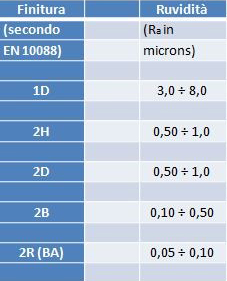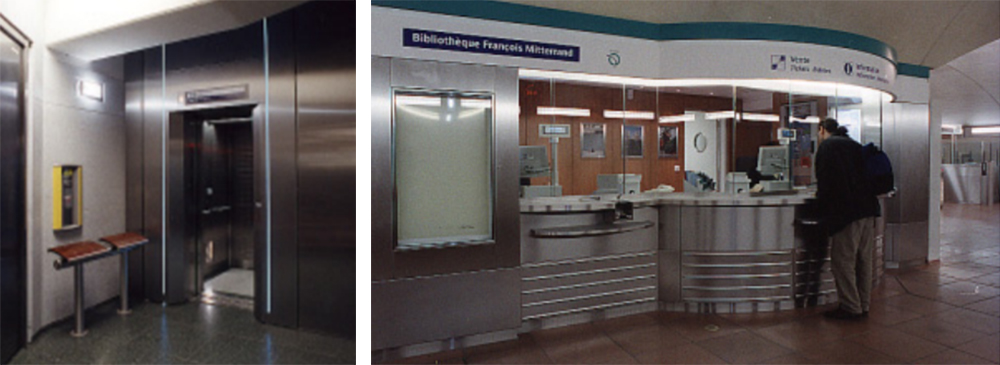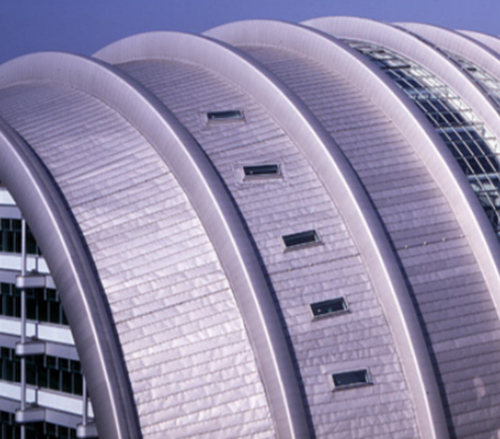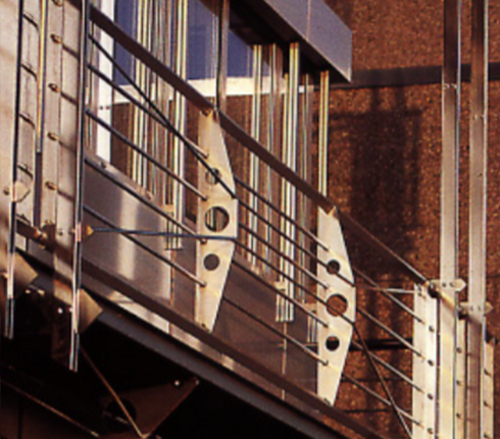Stainless steel is one of the most used materials in the construction industry due to its great versatility. The surface layer of stainless steel can be modified through a series of chemical processes, creating different surface finishes. Already in the preliminary phase, it is possible to define the desired type of finish for the stainless steel.
These are very important considerations since the finishes strongly influence the aesthetic impact of the steel surface as well as the behavior of the material with respect to the environment where it will be placed. Unsurprisingly, specific reference standards or final applications of the products will have to be clarified while ordering semi-finished products.
In this sense, there are two large families that classify stainless steel finishes:
- By abrasion
- By lamination
In the first case, the finishes are performed on stainless steel using abrasives of different granulometry, which will be used depending on the type of finish to be obtained: more opaque (polished) and hence characterized by lower reflectivity; smoother (mirror) and therefore featuring a higher degree of reflectivity.
As for the lamination processes, the standard steel mill finishes and the mechanical surface finishes of stainless steel in bars and slabs, both hot and cold rolled, are included in the EN 1008 part 2 standard and indicated with specific numbers:

Keyline:
1 = Hot Rolled (abbreviation 1 = HRC = hot rolled)
2 = Cold Rolled (2 = CRC = cold rolled)
D = dull (opaque)
H = hard (raw) which can be 1/4 HD raw, 1/2 HD raw, 3/4 HD raw, 4/4 HD raw;
B = bright (glossy)
R = reflective (reflective, also called BA)
The standard is in fact a valuable system for finding basic information and descriptions relating to the performance of the main finishing processes of stainless steel. These not only represent the basic supply conditions for all our flat products and stainless steel bars, but also constitute the starting point for subsequent finishes so that the steel can meet the aesthetic and functional requirements of architects and designers.

Extruded profiles by Siderval, cut and machined and subsequently subjected to two different finishes: “Mirror” (left) and “Polished” (central artifact). The extrusion on the right shows the raw state.
Both finishes have a Ra <1 µm roughness coefficient.
The stainless steel finishes that are essential in architecture and construction
In terms of construction, the most important finishes of stainless steel are four, each designated by a specific abbreviation. It is important to underline that, in order to increase the resistance of the material to corrosion phenomena, during the manufacturing phase the surfaces are subjected to pickling (a sort of cleaning with acid) to remove the scales caused by the hot rolling and annealing processes.
Let’s take a look at the main features of the essential finishes for standard steel components in the construction industry.

1D: it is a hot rolled and annealed surface, from which the steel scale is removed. The finish is slightly rough and characterized by low reflectivity. This finish is used for applications where the aesthetics of the manufact is not considered crucial, such as invisible support systems or structural applications.
2D: more refined than the previous one, this finish is obtained by cold rolling followed by heat treatment and pickling. It is a matte, low reflectivity finish suitable for industrial and engineering applications. In the architectural field, it is used for applications without any particular aesthetic requirements.

2B: this finish is obtained starting from the 2D model. It features a light final lamination obtained with the aid of very shiny rollers, which grants a particularly gray and milky appearance to the surface. The 2B finish is currently the most used and represents the foundation for subsequent stainless steel finishes, which can be polished or brushed.
2R: it is obtained through a heat treatment in controlled atmosphere conditions and, subsequently, by cold rolling with the aid of shiny rollers. This finish is typically characterized by a high reflectivity: it is therefore very glossy and offers greater slipperiness and a lower probability of contamination compared to other stainless steel finishes. It is also extremely easy to clean.
Mechanical polishing and brushing in stainless steel finishes
Mechanical polishing and brushing (or brushed finish) are treatments that, through the use of abrasive materials, affect the surface of the steel up to a certain depth.
Starting from the surface of the original stainless steel, the type and texture of the brushes and the nature of the polishing process used will allow to choose from a number of unidirectional finishes.

Stainless steel has been used extensively in the stations of the Paris underground – Line 14, as seen in these images.
An example is given by the mechanical finishes that can be performed with lubrification or dry, obtaining respectively shiny and low-roughness stainless steel finishes or polished effect finishes.
Typically, lubricated finishes are smoother and guarantee more unvarying results on different batches than dry finishes, and the appearance of the polished surfaces will be affected by the material and grain size of the emery belts.
Shot peening and electropolishing of stainless steel surfaces
In terms of stainless steel finishes, an important role is played by two processes:
- Shot peening
- Electropolishing
In the first case, the result will be a uniform, non-direction and low-reflectivity surface characterized by a pleasant contrast with very glossy surfaces. The processing involves the use of stainless steel grit, ceramic grains, aluminum oxides, glass fragments and walnut shells, each of with, with its own action, will give birth to a different aesthetic result.
In particular, as far as the finish of austenitic stainless steel is concerned, the shot peening process will result in the hardening of the surfaces and, in some cases, in the decrease in the tensions within the product. It may therefore be necessary to operate on all faces to balance the stresses.
| The Ludwig-Erhard Haus in Berlin is characterized by an extremely matte finish, obtained with shot peening by means of glass fragments. | The external surfaces of the stainless steel components of this building, located in an industrial context, have been electropolished both to improve their aesthetics and to facilitate maintenance. |
 |
 |
As for electropolishing, the term identifies an electrochemical process that can involve both stainless steel components with complex shapes and simple slabs. Its goal is to improve the surface of the material by eliminating irregularities, and therefore making it smoother and more reflective.
As you can easily guess, the final result will be influenced by the roughness of the material, but even in optimal conditions it is essential to remember that electropolishing will never guarantee a mirror reflectivity that is comparable to that obtained by mechanical polishing processes.
In conclusion: stainless steels, the main stars in construction, architecture and design
It is well known that stainless steels are widely used in a number of building, architectural and design applications not only because they are versatile and can be included in countless different artifacts, but also because they boast a “natural” protection from corrosion that does not require any further intervention.
Stainless steels are in fact protected by a surface film of chromium oxide, generated by the encounter between the chromium contained in the steel and the oxygen that is present in the atmosphere. Even if the surface of the stainless steel was damaged, the film would automatically regenerate simply thanks to the presence of oxygen.
This specific quality is an exceptional benefit in any application where steel is required, and is further implemented by the endless possibilities that this material offers in terms of finishes.
Photo 1 – For the food industry, Siderval manufactures a wide range of special steel profiles for food processing plants, but also for support and transport systems.
Photo 2 – The automotive painting system includes mainly stainless steel and duplex steel (W 1.4462) so as to effectively resist a chemically aggressive environment.
The finishes of stainless steel play a crucial role on a double front: that of the aesthetic appearance of the surfaces and that of the behavior of the material in its environment. For example, think of the close link between the surface conditions of stainless steel and its hygiene!
Ultimately, stainless steels – materials that, by nature, embody the true concept of versatility – are the subject of constant research in terms of surface finishes, and the results are beneficial to the most diverse industries: from construction to interior design, and even up to household appliances.



